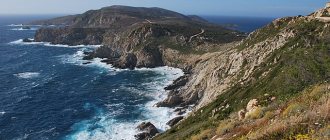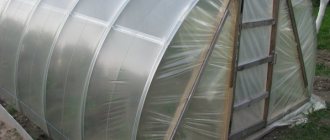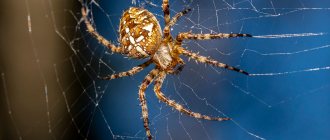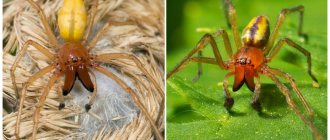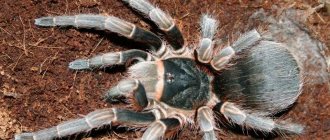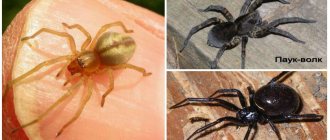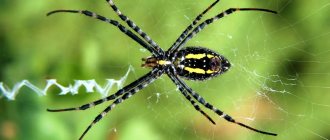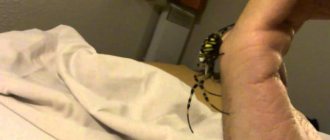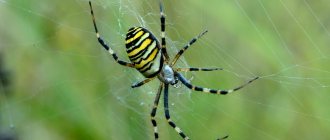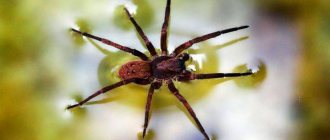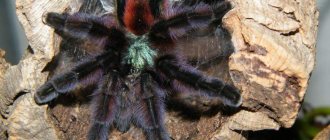17 August59309various animalskarakurtspidersdangerous animals
Karakurt is a spider from the black widow family. There are many different dangerous animals on our planet. Everyone knows that a polar bear or a crocodile poses a huge danger to humans. But these predators are huge and will not go unnoticed. You should know that creatures that are difficult to notice can pose a much greater danger, because they are no larger in size than a five-ruble coin. One of these is the karakurt spider. In this article you will find a description and photo of the karakurt spider, and also learn a lot of new and interesting things about this spider from the genus of black widows.
What does karakurt look like?
Karakurt looks like a medium-sized spider. Karakurt females are significantly larger than males in size. The female karakurt grows 2 cm in size, while the male karakurt is only 0.7 cm in size.
Karakurt looks quite unusual. The karakurt spider has a black body, and on its abdomen it has red or orange spots of various shapes. Both male and female karakurt have this coloration. Sometimes there may be a white outline around the spots. Often, upon reaching maturity, the karakurt spider can acquire a completely black color without spots.
Danger to humans
As a rule, males and young individuals do not pose a danger to humans, since they cannot bite through the skin with their weak jaws, although isolated cases of attacks are known. Adult females pose a danger, especially in July-August. You can distinguish the female by its color. Males have red spots with white rims, while females have no edging. Sometimes in females the red spots change to yellow stripes. Females have long legs up to 30 mm and are significantly larger than males.
The attack happens very quickly. Karakurt attacks only in self-defense. Nature has endowed the spider with such a strong poison so that it can capture the burrows of small rodents, which do not come into conflict with it and immediately vacate their territory. A predator can attack when it first seems to be in danger, so it is better to avoid contact with it. The difficulty in detecting danger lies in the fact that karakurts do not weave their net in the classical way. The threads are arranged horizontally, the web does not have a characteristic pattern and is chaotic. Attacks occur most often at night and on vacation, when you can accidentally crush the karakurt or disturb the web.
A spider bite is not painless, but it does not cause much concern. The bite site is marked with a small red spot, which disappears after a few minutes. After the poison has taken effect, the bitten person begins to experience severe pain in the damaged area. Specific psychological and physiological reactions arise.
In the first minutes and hours after the bite, poisoning is characterized by the following symptoms:
- strong mental agitation;
- feeling of fear of death, panic;
- spasms and suffocation;
- severe pain in the abdomen, chest and lower back;
- feeling that the legs are being taken away;
- bluish complexion;
- shallow breathing, dizziness;
- sometimes cramps of the arms and legs, tremors, vomiting;
- increased heart rate, arrhythmia;
- retention of urination and defecation;
- increased protein content in urine.
After the body’s initial reaction, a person experiences lethargy, apathy, weakness, depression, and sometimes delirium, but severe pain persists. After a few days, a red rash appears on the body. Death is possible in especially dangerous cases with general weakness of the body and lack of qualified medical care, especially if the victim has diseases of the cardiovascular system. If the course is favorable, recovery occurs within 3-4 weeks.
Where does the karakurt live?
Karakurt lives in Central Asia, Kyrgyzstan, Kazakhstan, Iran and Afghanistan, along the shores of the Mediterranean Sea, North Africa, southern Europe and Ukraine. In Russia, karakurt lives in the southern regions. The karakurt spider is especially common in the Astrakhan region, Krasnodar region and Crimea.
During particularly hot periods, this spider can migrate to the northern regions, but in such areas the karakurt lives only before the onset of winter. The most favorable living conditions for karakurt are those areas with hot summers and warm autumns. Karakurt lives in desert and steppe zones, wastelands, salt marshes, slopes of ravines and abandoned buildings.
Kinds
Spiders are distinguished by varying degrees of toxicity, habitat, and appearance features. Among the most poisonous spotted spiders, or thirteen-spotted spiders, there are Asian and European species. The latter are known by a second name - European widows.
Karakurt black widow. The belonging of arthropods to the genus of black widows reflects the peculiarity of females to devour males immediately after mating. In this way, the spider is fueled with energy to create and protect a clutch of eggs. The black spherical body is covered with red spots, of which there are 13. What is seen as a mystical sign.
This species is best known for its toxicity and distribution in the steppe zones of warm regions. The spider is 15-20 times more poisonous than the black cobra. To combat dangerous arthropods, chemical treatment of animal grazing areas is carried out. Dal's Karakurt is a monochromatic black spider. Capable of interbreeding with the thirteen-spotted species, which sometimes makes identification of offspring difficult.
Red Widow. The color is distinguished by a red-orange coloring on the top and black underbelly. The habitat is located in the USA, the Florida Peninsula. The limited distribution area is the reason for insufficient information about the degree of toxicity of the species.
White karakurt. The name reflects the specificity of the light yellowish color. Unlike its relatives, there are no spots, dots, or patterns. For a monochromatic spider, only the shades of color change. The limbs and cephalothorax are somewhat darker than the body.
On the back there are four dark dots, indentations forming a rectangle. The toxicity of the white karakurt is inferior to the black spider in the concentration of toxins. White spiders live in Central Asia, in the south of Russia. Females of this species are the largest among the karakurts; there are individuals up to 10 cm in limb span.
For its peculiar manner of movement with the characteristic tapping of its legs, the white karakurt is called a dancing spider. Those with perfect pitch transmit information to each other in this way. Spiders prefer to live in deserts, so in natural conditions, encounters with humans are extremely rare.
White spiders are most adapted to cold weather, so they are found in regions where it is already difficult for their black counterparts to survive, for example, in western Kazakhstan.
White karakurt is a very poisonous spider
The territory of Eurasia is inhabited by spiders that are very similar in appearance and shape to the poisonous karakurt - spiders from the genus Steatodes, or false widows.
The difference in color is white, beige, red spots, a thin yellow line on the back, and a red line along the abdomen. Red markings and the size of the false karakurt are the cause of confusion.
But steatodes are not so poisonous, although the symptoms of the poison have much in common with true representatives. After a false widow bite, the body recovers on its own after a few days.
Steatoda spiders are very similar in appearance to karakurt spiders
Karakurt bite
The poison of the karakurt is quite strong, so a bite from a karakurt can be fatal. Fortunately, the karakurt attacks only if it is disturbed. Karakurt poison affects both animals and humans. The karakurt bite is not immediately noticeable and manifests itself within 10-15 minutes. During this time, the karakurt poison is already spreading throughout the body and the first signs of toxic poisoning begin to appear. Symptoms of a karakurt bite begin with a burning pain that spreads throughout the body. Typically, patients complain of severe pain in the chest, abdomen and lower back.
Also, a karakurt bite has the following symptoms: increased heart rate, shortness of breath, palpitations, dizziness, headache, trembling, vomiting, sweating, spasms in the bronchi and urinary retention. In the later stages of poisoning, a person begins to experience blackouts and delirium. Cases of death have been recorded in people and farm animals that were bitten by karakurt.
Experts say that people with strong immunity can more easily withstand a karakurt bite than those weakened by illness or those with allergies. It should be remembered that the highest concentration of venom in black widows occurs during the mating season and after laying eggs; in other seasons, bites are less terrible. Males, in principle, do not pose a danger, since they do not possess poison and, due to their small size, cannot bite through the skin.
To neutralize the effects of karakurt poison, anti-karakurt serum is used. Novocaine, calcium chloride and magnesium hydrogen sulfate are also administered intravenously, which give positive results. If it is impossible to get medical help, you should cauterize the karakurt bite with a burning match. But this must be done no later than 5 minutes after the bite. You can also cauterize the bite site with a hot metal object. Since the spider bites through the skin to a depth of only 0.5 mm, the heat destroys the venom that has not had time to be absorbed. But even after cauterization, you must seek medical help.
Livestock suffers from karakurt bites, especially camels and horses. These animals often die from karakurt poison. Once every 10 years, a mass reproduction of the karakurt spider occurs; during these years, livestock farming suffers large losses. Now karakurt is destroyed with the help of insecticides that are sprayed on the soil. Of course, the poison of the karakurt is not aimed at causing harm to humans or livestock, but serves the spider only to obtain food. Karakurt eats various beetles, flies, locusts, cicadas and grasshoppers.
Why does the black widow bite
The spider itself is not so aggressive as to just attack a person. Usually he bites in case of danger, when something threatens life. Usually these animals, like many others like them, prefer to sit in ambush, waiting for food to fall into their net. They do not even attack or engage in combat with future prey. Therefore, a person can only get hurt by accident.
The bite of a female is dangerous. It is her jaws that can bite through human skin. The male is too small to cause any significant damage. Look carefully at the photo of the female black widow spider to know the danger in person.
When an enemy bites, you hardly feel it. The damage is so small that you won’t even notice it. But very soon the poison will begin to act, and the bitten area will begin to ache. The poison will then enter further into the circulatory system, spreading throughout the body. Painful cramps, muscle pain, clouding of consciousness - all this is possible after an attack by a black widow. In addition, men have another “side”: for several days an erection will be accompanied by severe pain. But then everything goes away.
The poison is of a nerve-paralytic nature. Hence the resulting convulsions and general depression of the nervous system. In the worst case scenario, death may occur. But now this rarely happens: antidotes have long been invented. In addition, many videos talking about karakurt advise consulting a doctor immediately as soon as you discover an inflamed bitten area. The first measure is to immediately cauterize the damage (for example, the head of a just extinguished match) to slow down the spread of the poison.
Karakurt cubs
The karakurt spider is called a black widow, since the female karakurt kills her husband after mating. But the black widow of the karakurt will not much outlive the eaten spouse, because with the onset of cold weather the female dies.
Karakurts become capable of reproducing at the beginning of summer and begin migrating in search of partners. With the onset of heat (July-August), females and males of karakurt arrange temporary mating networks. After which the female karakurt looks for a secluded place to set up a den, where she can place cocoons with eggs.
Such places often become various depressions in the soil, abandoned rodent holes, as well as drainage of ventilation systems. At the entrance to the lair, she stretches a chaotically intertwined web. The female karakurt hangs 2-4 cocoons in the den, where they will survive the winter.
In April, the karakurt cubs will leave their cocoons. With the onset of summer, mature karakurt cubs will go in search of partners. Despite the fact that the karakurt spider is very prolific and has a very strong poison, it still has enemies in nature. The enemies of the karakurt spider are hedgehogs, wasps and riders. It is also common for karakurt eggs to be destroyed by herds of sheep and pigs, who simply trample them.
If you liked this article and you like to read about a wide variety of animals on our vast planet, subscribe to site updates to be the first to receive the latest and most interesting articles about animals.
Don't forget to share with your friends!
Description of the spider
Name: Karakurt Lat.:
Latrodectus tredecimguttatusClass: Arachnida - Arachnida Order: Spiders - Araneae Family: Tenetiki - Theridiidae
| Habitats: | grass, ravines, fields |
| Dangerous for: | small insects |
| Attitude towards people: | bites, poisonous |
Are you afraid of spiders?
TerribleNo
The female karakurt is much larger than the male. Her body length can be from 7 to 20 mm, her partner’s is 4-7 mm. The abdomen is black; in young females it has 13 red spots bordered with white, but sometimes the spots may be absent.
On the underside of the abdomen, females have a red pattern, in the form of an hourglass, or two vertical stripes. The velvety body is covered with forked hairs.
The male differs from the female not only in size, but sometimes his body can be black with a brownish tint and white spots. The animal has 4 pairs of black legs, they are long and strong.
Spreading
The Karakurt spider lives in Southern Europe, Northern parts of Africa and Asia. In Russia, it is found in territories from the European part to the southern regions of Siberia.
Its favorite habitats are grassy areas, meadows, arable lands and open dry areas. It is found in sheds, vegetable gardens and even in people's homes. Karakurt can be seen on rocky and sandy shores.
The number of individuals of this species differs from year to year, but at intervals of 10-12 or 25 years there is a surge in the number of arthropods.
Lifestyle and reproduction
The spider weaves its webs on the ground, the hunting threads are stretched in different directions, and on top, above them, in the shape of a key, a shelter is made in which it stays at night. Usually the karakurt makes a web in the grass or between stones.
In the laboratory, spiders appear on day 49; in nature, this period lasts a little longer. Karakurt eggs are toxic, like other spiders of this species.
Preparation
The female migrates in May-June, finds a secluded place and makes temporary mating nets, and the sexually mature male looks for her. Once caught in the web, the male never leaves it.
Pairing
After the last molt, the female becomes sexually mature, the male binds her with a web and mates with her. After this, the female is quickly released from captivity and eats the male.
Masonry
After mating, she makes a lair, weaves up to 5 cocoons, in each of them she lays from 100 to 700 eggs and hangs them in her home. At first, the cocoons are white or cream-colored, then, closer to the appearance of the offspring, they become yellow.
Birth of cubs
Young individuals appear in April and are carried by the wind with cobwebs. Before becoming sexually mature adults, they go through several stages of molting, females - 8 times, males - 4-5 times.
Lifespan
Females live until November, their lifespan is approximately 302 days, males die in September, their lifespan is about 180 days.
